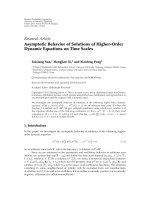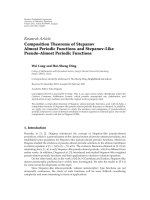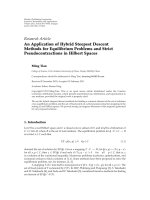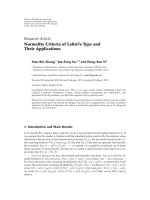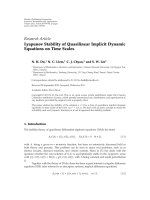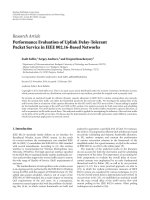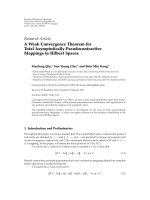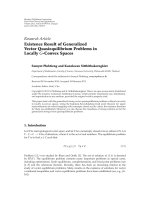Báo cáo hóa học: "Research Article Composition Theorems of Stepanov Almost Periodic Functions and Stepanov-Like Pseudo-Almost Periodic Functions" potx
Bạn đang xem bản rút gọn của tài liệu. Xem và tải ngay bản đầy đủ của tài liệu tại đây (504.7 KB, 12 trang )
Hindawi Publishing Corporation
Advances in Difference Equations
Volume 2011, Article ID 654695, 12 pages
doi:10.1155/2011/654695
Research Article
Composition Theorems of Stepanov
Almost Periodic Functions and Stepanov-Like
Pseudo-Almost Periodic Functions
Wei Long and Hui-Sheng Ding
College of Mathematics and Information Science, Jiangxi Normal University Nanchang,
Jiangxi 330022, China
Correspondence should be addressed to Hui-Sheng Ding,
Received 31 December 2010; Accepted 20 February 2011
Academic Editor: Toka Diagana
Copyright q 2011 W. Long and H S. Ding. This is an open access article distributed under the
Creative Commons Attribution License, which permits unrestricted use, distribution, and
reproduction in any medium, provided the original work is properly cited.
We establish a composition theorem of Stepanov almost periodic functions, and, with its help, a
composition theorem of Stepanov-like pseudo almost periodic functions is obtained. In addition,
we apply our composition theorem to study the existence and uniqueness of pseudo-almost
periodic solutions to a class of abstract semilinear evolution equation in a Banach space. Our results
complement a recent work due to Diagana 2008.
1. Introduction
Recently, in 1, 2, Diagana introduced the concept of Stepanov-like pseudo-almost
periodicity, which is a generalization of the classical notion of pseudo-almost periodicity, and
established some properties for Stepanov-like pseudo-almost periodic functions. Moreover,
Diagana studied the existence of pseudo-almost periodic solutions to the abstract semilinear
evolution equation u
tAtutft, ut. The existence theorems obtained in 1, 2 are
interesting since f·,u is only Stepanov-like pseudo-almost periodic, which is different from
earlier works. In addition, Diagana et al. 3 introduced and studied Stepanov-like weighted
pseudo-almost periodic functions and their applications to abstract evolution equations.
On the other hand, due to the work of 4 by N’Gu
´
er
´
ekata and Pankov, Stepanov-like
almost automorphic problems have widely been investigated. We refer the reader to 5–11
for some recent developments on this topic.
Since Stepanov-like almost-periodic almost automorphic type functions are not
necessarily continuous, the study of such functions will be more difficult considering
complexity and more interesting in terms of applications.
2 Advances in Difference Equations
Very recently, in 12, Li and Zhang obtained a new composition theorem of Stepanov-
like pseudo-almost periodic functions; the authors in 13 established a composition theorem
of vector-valued Stepanov almost-periodic functions. Motivated by 2, 12, 13, in this paper,
we will make further study on the composition theorems of Stepanov almost-periodic
functions and Stepanov-like pseudo-almost periodic functions. As one will see, our main
results extend and complement some results in 2, 13.
Throughout this paper, let R be the set of real numbers, let mesE be the Lebesgue
measure for any subset E ⊂ R,andX, Y be two arbitrary real Banach spaces. Moreover, we
assume that 1 ≤ p<∞ if there is no special statement. First, let us recall some definitions and
basic results of almost periodic functions, Stepanov almost periodic functions, pseudo-almost
periodic functions, and Stepanov-like pseudo-almost periodic functions for more details, see
2, 14, 15.
Definition 1.1. AsetE ⊂ R is called relatively dense if there exists a number l>0 such that
a, a l
∩ E
/
∅, ∀a ∈ R. 1.1
Definition 1.2. A continuous function f : R → X is called almost periodic if for each ε>0
there exists a relatively dense set Pε, f
⊂ R such that
sup
t∈R
f
t τ
− f
t
<ε, ∀τ ∈ P
ε, f
.
1.2
We denote the set of all such functions by AP R,X or APX.
Definition 1.3. A continuous function f : R × X → Y is called almost periodic in t uniformly
for x ∈ X if, for each ε>0 and each compact subset K ⊂ X, there exists a relatively dense set
Pε, f, K ⊂ R
sup
t∈R
f
t τ, x
− f
t, x
<ε, ∀τ ∈ P
ε, f,K
, ∀x ∈ K.
1.3
We denote by AP R × X, Y the set of all such functions.
Definition 1.4. The Bochner transform f
b
t, s, t ∈ R, s ∈ 0, 1,ofafunctionft on R,with
values in X, is defined by
f
b
t, s
: f
t s
.
1.4
Definition 1.5. The space BS
p
X of all Stepanov bounded functions, with the exponent p,
consists of all measurable functions f on R with values in X such that
f
S
p
: sup
t∈R
t1
t
f
τ
p
dτ
1/p
< ∞ 1.5
It is obvious that L
p
R; X ⊂ BS
p
X ⊂ L
p
loc
R; X and BS
p
X ⊂ BS
q
X whenever
p ≥ q ≥ 1.
Advances in Difference Equations 3
Definition 1.6. A function f ∈ BS
p
X is called Stepanov almost periodic if f
b
∈
APL
p
0, 1; X;thatis,forallε>0, there exists a relatively dense set Pε, f ⊂ R such
that
sup
t∈R
1
0
ft s τ − ft s
p
ds
1/p
<ε, ∀τ ∈ P
ε, f
.
1.6
We denote the set of all such functions by AP S
p
R,X or AP S
p
X.
Remark 1.7. It is clear that APX ⊂ APS
p
X ⊂ AP S
q
X for p ≥ q ≥ 1.
Definition 1.8. A function f : R × X → Y, t, u → ft, u with f·,u ∈ BS
p
Y, for each
u ∈ X, is called Stepanov almost periodic in t ∈ R uniformly for u ∈ X if, for each ε>0and
each compact set K ⊂ X, there exists a relatively dense set Pε, f,K ⊂ R such that
sup
t∈R
1
0
f
t s τ, u
− f
t s, u
p
ds
1/p
<ε,
1.7
for each τ ∈ Pε, f, K and each u ∈ K. We denote by APS
p
R × X, Y the set of all such
functions.
It is also easy to show that APS
p
R × X, Y ⊂ APS
q
R × X, Y for p ≥ q ≥ 1.
Throughout the rest of this paper, let C
b
R,Xresp. , C
b
R × X, Y be the space of
bounded continuous resp., jointly bounded continuous functions with supremum norm,
and
PAP
0
R,X
ϕ ∈ C
b
R,X
: lim
T → ∞
1
2T
T
−T
ϕ
t
dt 0
. 1.8
We also denote by PAP
0
R × X, Y the space of all functions ϕ ∈ C
b
R × X, Y such that
lim
T → ∞
1
2T
T
−T
ϕ
t, x
dt 0
1.9
uniformly for x in any compact set K ⊂ X.
Definition 1.9. A function f ∈ C
b
R,XC
b
R × X, Y is called pseudo-almost periodic if
f g ϕ 1.10
with g ∈ APXAPR × X, Y and ϕ ∈ PAP
0
R,XPAP
0
R × X, Y. We denote by
PAPXPAPR × X, Y the set of all such functions.
It is well-known that PAPX is a closed subspace of C
b
R,X,andthusPAPX is a
Banach space under the supremum norm.
4 Advances in Difference Equations
Definition 1.10. A function f ∈ BS
p
X is called Stepanov-like pseudo-almost periodic if it
can be decomposed as f g h with g
b
∈ APR,L
p
0, 1; X and h
b
∈ PAP
0
R,L
p
0, 1; X.
We denote the set of all such functions by PAPS
p
R,X or PAPS
p
X.
It follows from 2 that PAPX ⊂ PAPS
p
X for all 1 ≤ p<∞.
Definition 1.11. A function F : R × X → Y, t, u → ft, u with f·,u ∈ BS
p
Y, for each
u ∈ X, is called Stepanov-like pseud-almost periodic in t ∈ R uniformly for u ∈ X if it can be
decomposed as F GH with G
b
∈ APR×X, L
p
0, 1; Y and H
b
∈ PAP
0
R ×X, L
p
0, 1; Y .
We denote by PAPS
p
R × X, Y the set of all such functions.
Next, let us recall some notations about evolution family and exponential dichotomy.
For more details, we refer the reader to 16.
Definition 1.12. Aset{Ut, s : t ≥ s, t, s ∈ R} of bounded linear operator on X is called an
evolution family if
a Us, sI, Ut, sUt, rUr, s for t ≥ r ≥ s and t, r, s ∈ R,
b {τ, σ ∈ R
2
: τ ≥ σ}t, s → Ut, s is strongly continuous.
Definition 1.13. An evolution family Ut, s is called hyperbolic or has exponential
dichotomy if there are projections Pt, t ∈ R, being uniformly b ounded and strongly
continuous in t, and constants M, ω>0 such that
a Ut, sPsPtUt, s for all t ≥ s,
b the restriction U
Q
t, s : QsX → QtX is invertible for all t ≥ s and we set
U
Q
s, tU
Q
t, s
−1
,
c Ut, sPs≤Me
−ωt−s
and U
Q
s, tQt≤Me
−ωt−s
for all t ≥ s,
where Q : I − P. We call that
Γ
t, s
:
⎧
⎨
⎩
U
t, s
P
s
,t≥ s, t, s ∈ R,
−U
Q
t, s
Q
s
,t<s,t,s∈ R,
1.11
is the Green’s function corresponding to Ut, s and P ·.
Remark 1.14. Exponential dichotomy is a classical concept in the study of long-term behaviour
of evolution equations; see, for example, 16.Itiseasytoseethat
Γ
t, s
≤
⎧
⎨
⎩
Me
−ωt−s
,t≥ s, t, s ∈ R,
Me
−ωs−t
,t<s,t,s∈ R.
1.12
2. Main Results
Throughout the rest of this paper, for r ≥ 1, we denote by L
r
R × X, X the set of all the
functions f : R × X → X satisfying that there exists a function L
f
∈ BS
r
R such that
f
t, u
− f
t, v
≤ L
f
t
u − v
, ∀t ∈ R, ∀u, v ∈ X, 2.1
Advances in Difference Equations 5
and, for any compact set K ⊂ X, we denote by APS
p
K
R × X, Y the set of all the functions
f ∈ APS
p
R × X, Y such that 1.7 is replaced by
sup
t∈R
1
0
sup
u∈K
f
t s τ, u
− f
t s, u
p
ds
1/p
<ε.
2.2
In addition, we denote by ·
p
the norm of L
p
0, 1; X and L
p
0, 1; R.
Lemma 2.1. Let p ≥ 1, K ⊂ X be compact, and f ∈ APS
p
R × X, X
L
p
R × X, X.Then
f ∈ APS
p
K
R × X, X.
Proof. For all ε>0, there exist x
1
, ,x
k
∈ K such that
K ⊂
k
i1
B
x
i
,ε
.
2.3
Since f ∈ APS
p
R × X, X, for the above ε>0, there exists a relatively dense set Pε ⊂ R
such that
f
t τ ·,u
− f
t ·,u
p
<
ε
k
,
2.4
for all τ ∈ Pε, t ∈ R,andu ∈ K. On the other hand, since f ∈L
p
R × X, X, there exists a
function L
f
∈ BS
p
R such that 2.1 holds.
Fix t ∈ R, τ ∈ Pε. For each u ∈ K, there exists iu ∈{1, 2, ,k} such that u−x
iu
<
ε. Thus, we have
f
t s τ, u
− f
t s, u
≤ L
f
t s τ
ε
f
t s τ, x
iu
− f
t s, x
iu
L
f
t s
ε,
2.5
for each u ∈ K and s ∈ 0, 1, which gives that
sup
u∈K
f
t s τ, u
− f
t s, u
≤
L
f
t s τ
L
f
t s
ε
k
i1
f
t s τ, x
i
− f
t s, x
i
, ∀s ∈
0, 1
.
2.6
6 Advances in Difference Equations
Now, by Minkowski’s inequality and 2.4,weget
1
0
sup
u∈K
f
t s τ, u
− f
t s, u
p
ds
1/p
≤
1
0
L
p
f
t s τ
ds
1/p
· ε
1
0
L
p
f
t s
ds
1/p
· ε
k
i1
1
0
f
t s τ, x
i
− f
t s, x
i
p
ds
1/p
≤
2
L
f
S
p
1
ε,
2.7
which means that f ∈ APS
p
K
R × X, X.
Theorem 2.2. Assume that the following conditions hold:
a f ∈ APS
p
R × X, X with p>1, and f ∈L
r
R × X, X with r ≥ max{p, p/p − 1}.
b x ∈ AP S
p
X, and there exists a set E ⊂ R with mes E 0 such that
K :
{xt : t ∈ R \ E}
2.8
is compact in X.
Then there exists q ∈ 1,p such that f·,x· ∈ APS
q
X.
Proof. Since r ≥ p/p − 1, there exists q ∈ 1,p such that r pq/p − q.Let
p
p
p − q
,q
p
q
.
2.9
Then p
,q
> 1and1/p
1/q
1. On the other hand, since f ∈L
r
R × X, X, there is a
function L
f
∈ BS
r
R such that 2.1 holds.
It is easy to see that f·,x· is measurable. By using 2.1, for each t ∈ R, we have
t1
t
f
s, x
s
q
ds
1/q
≤
t1
t
f
s, x
s
− f
s, 0
q
ds
1/q
f
·, 0
S
q
≤
t1
t
L
q
f
s
x
s
q
ds
1/q
f
·, 0
S
q
≤
t1
t
L
r
f
s
ds
1/r
·
t1
t
x
s
p
dt
1/p
f
·, 0
S
q
≤
L
f
S
r
·x
S
p
f
·, 0
S
q
< ∞.
2.10
Thus, f·,x· ∈ BS
q
X.
Advances in Difference Equations 7
Next, let us show that f·,x· ∈ APS
q
X.ByLemma 2.1, f ∈ APS
p
K
R × X, X.In
addition, we have x ∈ AP S
p
X.Thus,forallε>0, there exists a relatively dense set Pε ⊂ R
such that
1
0
sup
u∈K
f
t s τ, u
− f
t s, u
p
ds
1/p
<ε,
x
t τ ·
− x
t ·
p
<ε
2.11
for all τ ∈ Pε and t ∈ R.Byusing2.11, we deduce that
1
0
f
t s τ, x
t s τ
− f
t s, x
t s
q
1/q
≤
1
0
L
q
f
t s τ
x
t s τ
− x
t s
q
1/q
1
0
f
t s τ, x
t s
− f
t s, x
t s
q
1/q
≤
1
0
L
r
f
t s τ
dt
1/r
·
1
0
x
t s τ
− x
t s
p
dt
1/p
1
0
f
t s τ, x
t s
− f
t s, x
t s
p
1/p
≤L
f
S
r
·x
t τ ·
− x
t ·
p
1
0
sup
u∈K
f
t s τ, u
− f
t s, u
p
ds
1/p
≤
L
f
S
r
1
ε
2.12
for all τ ∈ Pε and t ∈ R.Thus,f·,x· ∈ APS
q
X.
Lemma 2.3. Let K ⊂ X be compact, f ∈L
p
R × X, X, and f
b
∈ PAP
0
R × X, L
p
0, 1; X.Then
f ∈ PAP
0
R, R,where
f
t
sup
u∈K
f
t ·,u
p
,t∈ R.
2.13
Proof. Noticing that K is a compact set, for all ε>0, there exist x
1
, ,x
k
∈ K such that
K ⊂
k
i1
B
x
i
,ε
.
2.14
8 Advances in Difference Equations
Combining this with f ∈L
p
R × X, X, for all u ∈ K, there exists x
i
such that
f
t s, u
≤
f
t s, u
− f
t s, x
i
f
t s, x
i
≤ L
f
t s
ε
f
t s, x
i
2.15
for all t ∈ R and s ∈ 0, 1. Thus, we get
sup
u∈K
f
t s, u
≤ L
f
t s
ε
k
i1
f
t s, x
i
, ∀t ∈ R, ∀s ∈
0, 1
,
2.16
which yields that
f
t
sup
u∈K
f
t ·,u
p
≤L
S
p
· ε
k
i1
f
b
t, x
i
p
, ∀t ∈ R.
2.17
On the other hand, since f
b
∈ PAP
0
R × X, L
p
0, 1; X, for the above ε>0, there exists T
0
> 0
such that, for all T>T
0
,
1
2T
T
−T
f
b
t, x
i
p
dt <
ε
k
,i 1, 2, ,k.
2.18
This together with 2.17 implies that
1
2T
T
−T
f
t
dt ≤
L
f
S
p
1
ε.
2.19
Hence,
f ∈ PAP
0
R, R.
Theorem 2.4. Assume that p>1 and the following conditions hold:
a f g h ∈ PAPS
p
R × X, X with g
b
∈ APR × X, L
p
0, 1; X and h
b
∈ PAP
0
R ×
X, L
p
0, 1; X. Moreover, f,g ∈L
r
R × X, X with r ≥ max{p, p/p − 1};
b x y z ∈ PAPS
p
X with y
b
∈ APR,L
p
0, 1; X and z
b
∈ PAP
0
R,L
p
0, 1; X,
and there exists a set E ⊂ R with mes E 0 such that
K :
{y
t
: t ∈ R \ E}
2.20
is compact in X.
Then there exists q ∈ 1,p such that f·,x· ∈ PAPS
q
X.
Advances in Difference Equations 9
Proof. Let p, p
, and q
be as in the proof of Theorem 2.2. In addition, let ft, xt Ht
ItJt, where
H
t
g
t, y
t
,I
t
f
t, x
t
− f
t, y
t
,J
t
h
t, y
t
. 2.21
It follows from Theorem 2.2 that H ∈ APS
q
X,thatis,H
b
∈ APR,L
q
0, 1; X.
Next, let us show that I
b
,J
b
∈ PAP
0
R,L
q
0, 1; X. For I
b
, we have
1
2T
T
−T
I
b
t
q
dt
1
2T
T
−T
1
0
It s
q
ds
1/q
dt
≤
1
2T
T
−T
1
0
L
q
f
t s
z
t s
q
ds
1/q
dt
≤L
f
S
r
1
2T
T
−T
z
b
t
p
dt → 0,
T → ∞
,
2.22
where z
b
∈ PAP
0
R,L
p
0, 1; X was used. For J
b
,sinceh f − g ∈L
r
R × X, X ⊂L
p
R ×
X, X,byLemma 2.3, we know that
lim
T →∞
1
2T
T
−T
sup
u∈K
h
t ·,u
p
dt 0,
2.23
which yields
1
2T
T
−T
J
b
t
q
dt ≤
1
2T
T
−T
J
b
t
p
dt
1
2T
T
−T
1
0
h
t s, y
t s
p
ds
1/p
dt
≤
1
2T
T
−T
1
0
sup
u∈K
h
t s, u
p
ds
1/p
dt → 0
T → ∞
,
2.24
that is, J
b
∈ PAP
0
R,L
q
0, 1; X.Now,wegetf·,x· ∈ PAPS
q
X.
Next, let us discuss the existence and uniqueness of pseudo-almost periodic solutions
for the following abstract semilinear evolution equation in X:
u
t
A
t
u
t
f
t, u
t
. 2.25
10 Advances in Difference Equations
Theorem 2.5. Assume that p>1 and the following conditions hold:
a f g h ∈ PA P S
p
R × X, X with g
b
∈ APR × X, L
p
0, 1; X and h
b
∈ PAP
0
R ×
X, L
p
0, 1; X. Moreover, f, g ∈L
r
R × X, X with
r ≥ max
p,
p
p − 1
, r >
p
p − 1
;
2.26
b the evolution family Ut, s generated by At has an exponential dichotomy with constants
M,ω>0, dichotomy projections Pt,t∈ R, and Green’s function Γ;
c for all ε>0, for all h>0, and for all F ∈ AP S
1
X there exists a relatively dense set
Pε ⊂ R such that sup
r∈R
Fr · τ − fr · <εand
sup
r∈R
Γ
t r τ, s r τ
− Γ
t r, s r
<ε,
2.27
for all τ ∈ Pε and t, s ∈ R with |t − s|≥h.
Then 2.25 has a unique pseudo-almost periodic mild solution provided that
L
f
S
r
<
1 − e
−ω
2M
·
ωr
1 − e
−ωr
1/r
, where
1/r
1/r
1.
2.28
Proof. Let u v w ∈ PAPX, where v ∈ APX and w ∈ PAP
0
X. Then u ∈ PAPS
p
X
and K :
{vt : t ∈ R} is compact in X. By the proof of Theorem 2.4, there exists q ∈ 1,p
such that f·,u· ∈ PAPS
q
X.
Let
f
t, u
t
f
1
t
f
2
t
,t∈ R, 2.29
where f
b
1
∈ APR,L
q
0, 1; X and f
b
2
∈ PAP
0
R,L
q
0, 1; X. Denote
F
u
t
:
R
Γ
t, s
f
s, u
s
ds F
1
u
t
F
2
u
t
,t∈ R,
2.30
where
F
1
u
t
R
Γ
t, s
f
1
s
ds, F
2
u
t
R
Γ
t, s
f
2
s
ds.
2.31
Advances in Difference Equations 11
By 13, Theorem 2.3 we have F
1
u ∈ APX. In addition, by a similar proof to that of 2,
Theorem 3.2, one can obtain that F
2
u ∈ PAP
0
X.SoF maps PAPX into PAPX. For
u, v ∈ PAPX,byusingtheH
¨
older’s inequality, we obtain
F
u
t
− F
v
t
≤
R
Γ
t, s
·
f
s, u
s
− f
s, v
s
ds
≤
t
−∞
Me
−ωt−s
L
f
s
ds ·
u − v
∞
t
Me
−ωs−t
L
f
s
ds ·
u − v
≤
2M
1 − e
−ω
1 − e
−ωr
ωr
1/r
L
f
S
r
·
u − v
,
2.32
for all t ∈ R, which yields that F has a unique fixed point u ∈ PAPX and
u
t
R
Γ
t, s
f
s, u
s
ds, t ∈ R.
2.33
This completes the proof.
Remark 2.6. For some general conditions which can ensure that the assumption c in
Theorem 2.5 holds, we refer the reader to 17, Theorem 4.5. In addition, in the case of
At ≡ A and A generating an exponential stable semigroup Tt, the assumption c
obviously holds.
Acknowledgments
The work was supported by the NSF of China, the Key Project of Chinese Ministry of
Education, the NSF of Jiangxi Province of China, the Youth Foundation of Jiangxi Provincial
Education Department GJJ09456, and the Youth Foundation of Jiangxi Normal University
2010-96.
References
1 T. Diagana, “Stepanov-like pseudo almost periodic functions and their applications to differential
equations,” Communications in Mathematical Analysis, vol. 3, no. 1, pp. 9–18, 2007.
2 T. Diagana, “Stepanov-like pseudo-almost periodicity and its applications to some nonautonomous
differential equations,” Nonlinear Analysis. Theory, Methods & Applications, vol. 69, no. 12, pp. 4277–
4285, 2008.
3 T. Diagana, G. M. Mophou, and G. M. N’Gu
´
er
´
ekata, “Existence of weighted pseudo-almost
periodic solutions to some classes of differential equations with S
p
-weighted pseudo-almost periodic
coefficients,” Nonlinear Analysis. Theory, Methods & Applications, vol. 72, no. 1, pp. 430–438, 2010.
4 G. M. N’Gu
´
er
´
ekata and A. Pankov, “Stepanov-like almost automorphic functions and monotone
evolution equations,” Nonlinear Analysis. T heory, Methods & Applications, vol. 68, no. 9, pp. 2658–2667,
2008.
5 T. Diagana, “Existence of pseudo-almost automorphic solutions to some abstract differential
equations with S
p
-pseudo-almost automorphic coefficients,” Nonlinear Analysis. Theory, Methods &
Applications, vol. 70, no. 11, pp. 3781–3790, 2009.
12 Advances in Difference Equations
6 T. Diagana, “Existence of almost automorphic solutions to some classes of nonautonomous higher-
order differential equations,” Electronic Journal of Qualitative Theory of Differential Equations, vol. 22, pp.
1–26, 2010.
7 H S. Ding, J. Liang, and T J. Xiao, “Almost automorphic solutions to nonautonomous semilinear
evolution equations in Banach spaces,” Nonlinear Analysis. Theory, Methods & Applications, vol. 73, no.
5, pp. 1426–1438, 2010.
8 H S. Ding, J. Liang, and T J. Xiao, “Some properties of Stepanov-like almost automorphic functions
and applications to abstract evolution equations,” Applicable Analysis, vol. 88, no. 7, pp. 1079–1091,
2009.
9 Z. B. Fan, J. Liang, and T. J. Xiao, “On Stepanov-like pseudo almost automorphic functions,”
Nonlinear Analysis: Theory, Methods and Applications, vol. 74, no. 8, pp. 2853–2861, 2011.
10 Z. B. Fan, J. Liang, and T. J. Xiao, “Composition of Stepanov-like pseudo almost automorphic
functions and applications to nonautonomous evolution equations,” preprint.
11 H S. Ding, J. Liang, and T J. Xiao, “Almost automorphic solutions to abstract fractional differential
equations,” Advances in Difference Equations, vol. 2010, Article ID 508374, 9 pages, 2010.
12 H X. Li and L L. Zhang, “Stepanov-like pseudo-almost periodicity and semilinear differential
equations with uniform continuity,” Results in Mathematics, vol. 59, no. 1-2, pp. 43–61, 2011.
13 H. S. Ding, W. Long, and G. M. N’Gu
´
er
´
ekata, “Almost periodic solutions to abstract semilinear
evolutionequations with Stepanov almost periodic coeffcient,” Journal of Computational Analysis and
Applications, vol. 13, pp. 231–243, 2011.
14 A. A. Pankov, Bounded and Almost Periodic Solutions of Nonlinear Operator Differential Equations, vol. 55,
Kluwer Academic Publishers, Dordrecht, The Netherlands, 1990.
15 B. M. Levitan and V. V. Zhikov, Almost Periodic Functions and Differential Equations, Cambridge
University Press, Cambridge, UK, 1982.
16 K J. Engel and R. Nagel, One-Parameter Semigroups for Linear Evolution Equations, vol. 194 of
Graduate
Texts in Mathematics, Springer, New York, NY, USA, 2000.
17 L. Maniar and R. Schnaubelt, “Almost periodicity of inhomogeneous parabolic evolution equations,”
in Evolution Equations, vol. 234, pp. 299–318, Marcel Dekker, New York, NY, USA, 2003.
